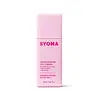What's inside
What's inside
 Key Ingredients
Key Ingredients

 Benefits
Benefits

 Concerns
Concerns

 Ingredients Side-by-side
Ingredients Side-by-side

Water
Skin ConditioningGlycerin
HumectantCaprylic/Capric Triglyceride
MaskingPentaerythrityl Tetraethylhexanoate
EmollientNiacinamide
SmoothingCeramide NP
Skin ConditioningCholesterol
EmollientPhytosphingosine
Skin ConditioningPolyglyceryl-3 Methylglucose Distearate
EmulsifyingStearic Acid
CleansingOleic Acid
EmollientLactic Acid
BufferingTromethamine
BufferingCamellia Sinensis Leaf Extract
AntimicrobialHydroxyacetophenone
AntioxidantCetearyl Alcohol
EmollientCarbomer
Emulsion StabilisingXanthan Gum
Emulsifying1,2-Hexanediol
Skin ConditioningWater, Glycerin, Caprylic/Capric Triglyceride, Pentaerythrityl Tetraethylhexanoate, Niacinamide, Ceramide NP, Cholesterol, Phytosphingosine, Polyglyceryl-3 Methylglucose Distearate, Stearic Acid, Oleic Acid, Lactic Acid, Tromethamine, Camellia Sinensis Leaf Extract, Hydroxyacetophenone, Cetearyl Alcohol, Carbomer, Xanthan Gum, 1,2-Hexanediol
Colloidal Oatmeal 5%
AbsorbentWater
Skin ConditioningSqualane
EmollientPropanediol
SolventCetearyl Olivate
Sorbitan Olivate
EmulsifyingCoco-Caprylate/Caprate
EmollientMusa Sapientum Leaf Extract
Skin ConditioningCetyl Alcohol
EmollientAvena Sativa Kernel Extract
AbrasiveBetaine
HumectantButyrospermum Parkii Butter
Skin ConditioningPolyglyceryl-10 Myristate
Skin ConditioningHydrogenated Lecithin
EmulsifyingPhysalis Pubescens Fruit Juice
Skin ConditioningAlbatrellus Confluens Extract
HumectantNiacinamide
SmoothingAllantoin
Skin ConditioningTocopherol
AntioxidantJojoba Esters
EmollientEthylhexylglycerin
Skin ConditioningCaprylic/Capric Triglyceride
MaskingHectorite
AbsorbentCarbomer
Emulsion StabilisingCaprylhydroxamic Acid
Tetrasodium Glutamate Diacetate
Sodium Hydroxide
BufferingCitric Acid
BufferingChlorphenesin
AntimicrobialColloidal Oatmeal 5%, Water, Squalane, Propanediol, Cetearyl Olivate, Sorbitan Olivate, Coco-Caprylate/Caprate, Musa Sapientum Leaf Extract, Cetyl Alcohol, Avena Sativa Kernel Extract, Betaine, Butyrospermum Parkii Butter, Polyglyceryl-10 Myristate, Hydrogenated Lecithin, Physalis Pubescens Fruit Juice, Albatrellus Confluens Extract, Niacinamide, Allantoin, Tocopherol, Jojoba Esters, Ethylhexylglycerin, Caprylic/Capric Triglyceride, Hectorite, Carbomer, Caprylhydroxamic Acid, Tetrasodium Glutamate Diacetate, Sodium Hydroxide, Citric Acid, Chlorphenesin
 Reviews
Reviews

Ingredients Explained
These ingredients are found in both products.
Ingredients higher up in an ingredient list are typically present in a larger amount.
This ingredient is an emollient, solvent, and texture enhancer. It is considered a skin-softener by helping the skin prevent moisture loss.
It helps thicken a product's formula and makes it easier to spread by dissolving clumping compounds.
Caprylic Triglyceride is made by combining glycerin with coconut oil, forming a clear liquid.
While there is an assumption Caprylic Triglyceride can clog pores due to it being derived from coconut oil, there is no research supporting this.
Learn more about Caprylic/Capric TriglycerideCarbomer is a polymer of acrylic acid. Its main role is to create a gel consistency.
A high amount of carbomer can cause pilling or balling up of products. Don't worry, most products contain 1% or less of carbomer.
Niacinamide is a multitasking form of vitamin B3 that strengthens the skin barrier, reduces pores and dark spots, regulates oil, and improves signs of aging.
And the best part? It's gentle and well-tolerated by most skin types, including sensitive and reactive skin.
You might have heard of "niacin flush", or the reddening of skin that causes itchiness. Niacinamide has not been found to cause this.
In very rare cases, some individuals may not be able to tolerate niacinamide at all or experience an allergic reaction to it.
If you are experiencing flaking, irritation, and dryness with this ingredient, be sure to double check all your products as this ingredient can be found in all categories of skincare.
When incorporating niacinamide into your routine, look out for concentration amounts. Typically, 5% niacinamide provides benefits such as fading dark spots. However, if you have sensitive skin, it is better to begin with a smaller concentration.
When you apply niacinamide to your skin, your body converts it into nicotinamide adenine dinucleotide (NAD). NAD is an essential coenzyme that is already found in your cells as "fuel" and powers countless biological processes.
In your skin, NAD helps repair cell damage, produce new healthy cells, support collagen production, strengthen the skin barrier, and fight environmental stressors (like UV and pollution).
Our natural NAD levels start to decline with age, leading to slower skin repair, visible aging, and a weaker skin barrier. By providing your skin niacinamide, you're recharging your skin's NAD levels. This leads to stronger, healthier, and younger looking skin.
Another name for vitamin B3 is nicotinamide. This vitamin is water-soluble and our bodies don't store it. We obtain Vitamin B3 from either food or skincare. Meat, fish, wheat, yeast, and leafy greens contain vitamin B3.
The type of niacinamide used in skincare is synthetically created.
Learn more about NiacinamideWater. It's the most common cosmetic ingredient of all. You'll usually see it at the top of ingredient lists, meaning that it makes up the largest part of the product.
So why is it so popular? Water most often acts as a solvent - this means that it helps dissolve other ingredients into the formulation.
You'll also recognize water as that liquid we all need to stay alive. If you see this, drink a glass of water. Stay hydrated!
Learn more about Water